DSM150, Maretron for the masses?
When Kees spotted Maretron’s new little display at METS, it didn’t seem like a big deal. In fact, it’s fairly homely compared to other contemporary NMEA 2000 all-in-one displays like the B&G Triton and the Raymarine i70. But now that the DSM150 is fully detailed, I think it represents a significant new opportunity for boaters who used to think that Maretron gear was out of their league…
It was good to hear Kee’s comment about how sharp the DSM150 screen looks because it packs the same 320 x 240 pixels onto its 3.5-inch screen as Maretron’s DSM250 does on its 5.7-inch screen, but what seems really significant is that the 150 is half the price of the 250 while using about 25% of the power and taking up much less helm or panel space. So the 150 is similar in size, power needs and price to the aforementioned i70 or Triton all-in-ones (or Triton’s Simrad i40 Color sibling or Garmin’s venerable GMI-10), but “all-in-one” is a vague term. All these displays will show conventional N2K data like depth, wind, heading, etc. and most all have some special abilities like the i70’s AIS display or the Triton’s handsome True/Apparent Wind graphic or Garmin’s sophisticated engine screens. But Maretron “all-in-one” is nearly another world altogether…
Over the years Maretron has developed an amazing array of NMEA 2000 sensors and other utility hardware, many of which aren’t available elsewhere and all of which can be displayed, alarmed, configured, and managed with a DSM150. Maretron has also made good use of native N2K capabilities like Instances and Labels that other companies have largely ignored. The light and pump switch screen seen above is an example of both as those are custom labels for channels on a DCR100 DC Relay. But up until now the control and display of all this goodness required a DSM250 at minimum and was largely directed toward Maretron’s powerful N2KView software. I’m sure I’m not the only mid-size boat owner who’s gotten jealous of big Maretron installs like the one I saw at Lyman Morse last spring. It’s not that I need that big, bright touch screen or the dedicated N2KView computers, but I’d sure like access to some of Maretron’s specialized black boxes.
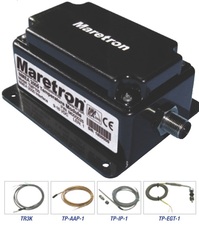
I have a good example. I count myself lucky that an engine room check revealed a main engine coolant leak while I was moving down the ICW in late September and thus I was fairly well prepared when the engine’s heat alarm let me know that the leak had gotten drastically worse. But it’s easy to picture a different scenario that might have drastically messed up my cruise plan and my bank account! That’s why I’d like to install a Maretron TMP100 Temperature Monitor that could not only keep a redundant finger on the engine block but also measure exhaust and three other temperatures that might save me heartache from future mechanical failures. Or even make life aboard easier, as in “Has the engine heated the domestic water yet?”
With the advent of the DSM150 the hardware portion of the TMP100 install would be about $1,000 (depending on which of the four available probes are selected) and the results should be slick. It’s a little daunting at over 200 pages but if you download the manual from the the DSM150 page, you’ll see that it’s possible to choose a standard N2K source for each channel — like “Bait Well” or “Heating System” — as well as to apply a custom label for each temperature and the box itself, as suggested on the configuration screen below (top left). The labels will probably only show up on the DSM150 or other Maretron displays and software, but I believe that other manufacturers could support this function.
In fact, you can pretty much count on Maretron gear working as well as possible with N2K gear from other manufacturers. For instance, once NMEA finally finishes a set of Standard Power messages (PGNs), I’ll bet that the DCR100 relays — which can also measure current — will be operable by more than Maretron displays. And consider how a small Maretron system could grow. Besides for various other sensors able to monitor fuel flow, fluid pressures, 12v battery and AC states, etc. etc., Maretron has already developed ways to get this information into WiFi and even off the boat. Note how the DSM150 screen below (lower right) can configure an IPG100 Internet Protocol Gateway.
Be aware, though, that as once discussed on Panbo, the IPG100 is currently limited to use with N2KView software. But if Maretron is trying to expand its market to smaller boats, maybe it will open its gateway to third party apps? Wouldn’t it then make sense for the adventurous folks who are trying to go all iPad or similar to also use the company’s GPS, Depth/Speed/Temp, Heading, and Weather sensors (which have been working fine with everything on Gizmo for years)? Please speak up if you like this idea.
But even if Maretron doesn’t go that far in opening up its systems, the DSM150 just made a lot of interesting possibilities more feasible for smaller boats and budgets.


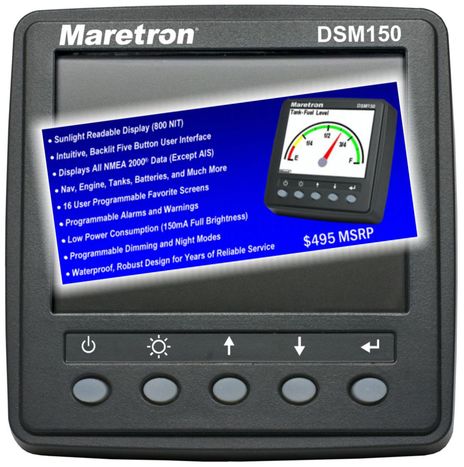
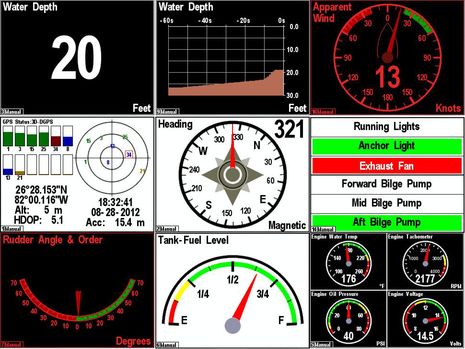
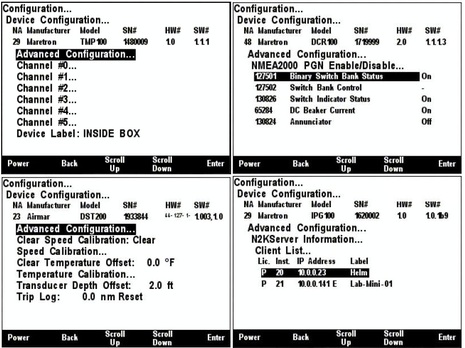
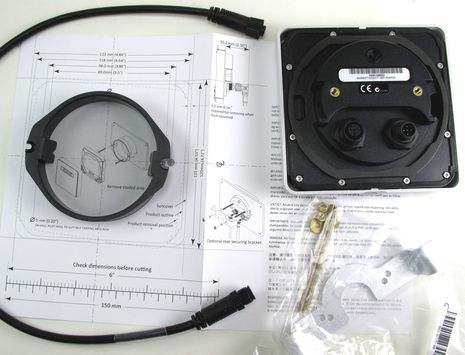
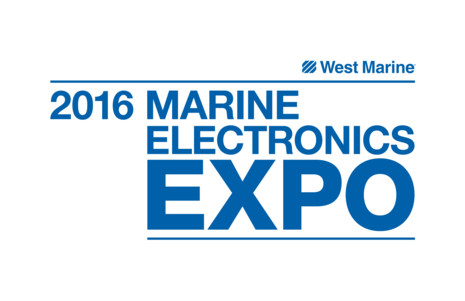
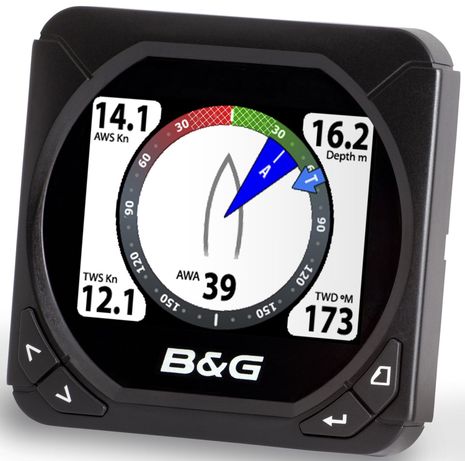
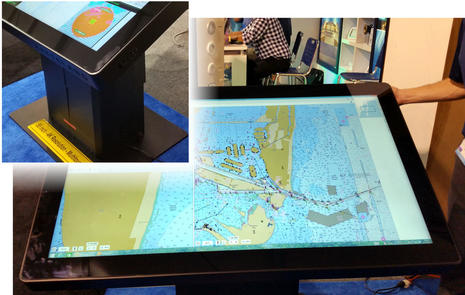







Another thing I’d encourage Maretron to consider is a redesign of the USB100. It works fine for Maretron software like (free) N2KAnalyzer, which nicely abet the DSM150 (it’s a lot easier to type Label names with a keyboard instead of working the DSM’s buttons).
But the way it delivers (limited) NMEA 0183 translations to third party software, instead of N2K PGNs, has gotten old-fashioned. The same boaters who might well try a small Maretron subsystem like the temp sensor I discussed may also be running, or want to run, charting or other software that can now understand straight NMEA 2000. Honk if you agree 😉
Like Ben, I am a big fan of Maretron and capabilities of their hardware.
I received a couple DSM150s a few weeks back to replace a couple troublesome Raymarine ST70 displays. I haven’t installed them yet, but have noted a couple things:
The most important is that the DSM150s–at roughly 3 3/4 inches square are noticeably smaller than other displays. (Which topically are around 4 1/2 inches.) For fresh installs, this won’t matter, but if you are upgrade from older displays, you are going to have a repair job of some sort. (I ordered a fascia from Front Panel Express to cover the old holes from the ST70s.)
The second is really just a curiosity: The DSM150s have a Deutsch connector on their back and use a patch cable connect to the NMEA 2000 network. No big deal, but this is certainly unusual.
For a sailor the Maretron DSM150 is nice but compared to the B&G Triton with dual true/apparent wind on the same screen I would have to lean toward the Triton.
However, since I’m almost all Garmin onboard and GMI-10 software updates from Garmin are easy to do and issued often I will wait to see what whiz bang new instrument display Garmin comes up with next – hopefully soon. I’m ready to abandon a few very old Nexus (0183) displays and would like to stay with the Garmin family if they can match the beautiful true/apparent wind display screen on the Triton.
Ben wrote “please speak up if you like the idea”.
1. “Yes”, opening up to 3rd party apps. Ben did you mean apps running in the display, or on a smartphone or tablet on the boat?
2. Considering how extremely configurable this display is, and that the display allows you to then configure sensors (change id, name each tank sensor, etc.), how about a 3rd party app for configuring the display and allow changes to be sent over the air to the displays.
The touch screen interface would require far fewer clicks than pressing up or down arrows to pick each letter of a tank name, one by one.
3. Reduced power requirements is a big deal. This makes the N2K battery monitor / display combination more attractive.
A couple things make configuring the display (and the DSM250) easier. The first is that a configuration can be saved to a PC and copied to another display. the a PC can be used to configure device labels that the are used by the DSMs.
Both approaches will require Maretron’s N2K Analyzer software and USB100 hardware. (Note Ben’s comments above re. the USB100, which are true.)
As far as Ben’s question about the IPG100 being “closed,” I would agree this is a limitation. Perhaps some people don’t care, but the reason I am using Seasmart to get N2K data over wifi is because the IPG–even though it is more capable–is a closed device.
BTW, if you are comparing the DSM displays with others, something else to be aware of: Most displays will divide the screen in a 2/3, 1/6, 1/6 configuration. This works well with a gauge (or wind graphic) and a couple numeric data elements. Don’t think either DSM displays will offer this configuration.
The spec might be good, but I am sorry these look horrendous, cheap and not fit for purpose.
Sorry if it sounds a bit strong, but I am getting fed up with marine companies that do not give any consideration in the way the unit looks and the way it fits in with it environment and users.
Thanks, Jeremy. In the comments to Kees’ METS report, Dave identified the DSM150 as the Cantronic CANvu 350 OEM display, which looks true: http://tinyurl.com/a2jyvyj
That would explain the Deutsch connector and the relatively low price. Dave also said that “It’s ARM based running Linux (in some versions).”
Hi Dan, Of course I meant phone and tablet apps. I know you love the idea of configuring marine electronics with your phone but, sorry, I don’t think it’s practical at this level, at least not now. But that said, “typing” on the DSM150 is going to be darn tedious, as I once described on regarding the 250 — http://tinyurl.com/panbo-DSM250
So the PC helpers that Jeremy described, which are unique to Maretron I think, are useful. Also, if you look in the DSM150 manual it seems possible to copy alarms, device selection, and screen settings from one 150 to another or to a 250 without a PC involved.
Richard, Garmin is promising lots of new stuff at Miami and I sure wouldn’t be surprised if that includes a “GMI-15” or something (purely guess work). Here’s a challenge for screen designers: Triton-like True/Apparent graphic with Min/Max markers like Raymarine introduced with ST70 and option to go auto upwind/downwind close-hauled style like Garmin introduced on GMI10 😉
Expand Ben’s challenge for screen designers: Auto adjust display intensity for current lighting conditions as B&G has for years, user selected and auto scale STW digit sizes like i70; allow two different N2K STW speed sources to be displayed side by side as Maretron does; allow N2K sources to be relabeled like Maretron; amazingly easy to configure as i70 lighthouse interface is.
One of the differentiating features about the Maretron display is the depth of information a user can configure and obtain from each sensor allowing the display to substitute for dedicated displays and wiring typical of products such as tank sensors and battery monitors.
For example while most displays allow a choice to display battery voltage, they are no substitute for a battery monitor.
The Maretron display provides the full depth of functionality for a battery monitor. The user can enter the size of the battery bank, and in return get detailed information to understand how much power is being consumed / remains in each battery bank providing the equivalent feature set as the Xantrex Link 20 including the sophisticated Peukert math performed by the battery monitor necessary to accurately estimate battery capacity while the battery is under load. When your battery manufacturer says don’t discharge below 50% or 20%, you actually have a way to measure and know when you are approaching empty, or while charging how close you are to 100% just like the Link20.
Right, Dan, that’s because Maretron makes a battery monitor sensor, the DCM100. I think that all the NMEA 2000 displays can stand in for various standalone displays; it’s just that Maretron makes a whole lot of sensors others don’t.
Ben, I agree that Maretron making additional sensor modules does contribute a lot more possible info to their displays, but I also think it’s important to note that even without those particular Maretron sensors, the DSM250 & now 100 displays seem to also be receptive to a lot more of the N2K PGNs than the others.
E.G. the DSM manuals list 32 received data PGNs (apart from the N2K system & protocol PGNs), whereas the Garmin GMI10 manual lists only 21 (once you take out the system PGNs). I couldn’t find any PGN listings for either the Triton or the Ray i70, but the i70 manual lists “Data Views” in their manual and those don’t seem to have as much info available as the Maretrons either.
So it would seem to me that the Maretron displays are more flexible displays inherently in an N2K system, not just when combined with the other Maretron hardware.
We’ve run 4 * DSM250s now for 2 years, and I really like their size and flexibility, even though the graphics aren’t as nice as the Triton, Garmin, & Ray offerings.
Cheers,
Paul.
Oops, sorry, meant to say “DSM250 & now 150” (not DSM 100).
Here’s a technical PGN question on the 150 & 250, for anyone with knowledge of these things (are you reading this, Maretron? :)).
In the DSM manual the PGN listing at the back shows PGN 127508 is received for the battery status, but none of the other battery PGNs. However, the DSM displays can also show state-of-charge, time-remaining, etc, and can set Peukert’s exponent, temp coefficient, etc. These require being able to receive at least PGNs 127506 & 127513 as well, but these aren’t listed.
Anyone know why they aren’t listed?
It could mean that the listing of 31 PGNs I mentioned in my above post is actually not the complete set, making the displays even more flexible than the other displays on the market.
But why wouldn’t Maretron list all those PGN’s?
Also, if Maretron is reading this, you have a serious page numbering issue with the latest downloadable DSM250 & 150 manuals (v 1.4.16 for both). Both in the contents & actual pages, you get to page 11, and then restart at page 2. Quite confusing.
Cheers,
Paul.
Maretron response: “The DSM150/DSM250 do receive 127506 and 127513, along with other PGN’s not listed there. The DSM150/DSM250 manuals need to be updated with respect to the received PGN’s. We’ll address this soon, along with the page numbering issue.”
Thanks for the quick reply from Maretron – nice to see them keeping an eye on e-space.
I think for anyone putting together an N2K network with different manufacturer’s components it’s important to make sure that the displays you’re using can display all the different PGNs you want to see. It seems that the Maretron displays are ahead of the others in number of PGNs.
Also, from my search of the other displays, it seems that Garmin is the only other manufacturer to list the PGNs. So Simrad, B&G (or Navico in general), & Raymarine seem to have a way to go in making their documentation more broadly pitched for general N2K networks.
Cheers,
Paul.
Not all of them have begun to publish their PGNs including Simrad and Raymarine
Dave
All-in-one displays seem to be particularly poor in terms of PGN publishing, probably because most aren’t NMEA 2000 certified due to the daisy chaining issue. However, certified products are required to publish PGN lists, at least online, and the manufacturers are pretty good about it, including Raymarine and Simrad.
For instance, if you check out the a-, c-, e-Series manual you’ll find a nice table of PGN numbers, descriptions, and transmit/receive/bridge status. The Simrad NSS manual also has a PGN list and I notice that it seems to include proprietary PGNs (the ones above 130800).
Which brings me to the mystery of the day. Why would a Simrad NSS be able to transmit a special PGN for “Fluid Level Insect Configuration”? I don’t think that’s a typo as there’s another PGN for “Pressure Insect Configuration”!
Maybe they’re working on insect size nanobots that will live in our engines and keep them clean 🙂 – cool!
But probably it’s a typo – maybe they mean “inspect config”? Doesn’t make total sense, but maybe more so than “insect” 🙂
Your rationale for them not publishing the PGNs in the all-in-one display manuals sounds logical, Ben. But it does bring up another question – is there now enough real world use of N2K networks to indicate whether daisy-chaining is, or is not, a problem to networks? I’d imagine that there should be. And if that’s so, then surely it’s time for either N2K, or the manufacturers who promote daisy-chaining, to change their position, depending on which way the evidence points.
It seems to be a real shame that Simrad, Raymarine, etc are either prevented from, or choose not to, publish PGN lists for products which work with N2K. And as I said in an above post, it means that users can’t evaluate which display might meet their requirements properly.
Maybe it’s time for a more pragmatic approach to that issue?
Cheers,
Paul.
Paul, I don’t think there’s anything stopping manufacturers from thoroughly documenting PGN use, regardless of a product’s certification status.
Maretron has always been excellent about such documentation. I just looked over the manual for the TMP100 and it explains how some PGNs are only there for backward compatibility (with an inter-operable Standard you can not redefine or delete a PGN, just add new ones). They also break down each PGN into its fields and explain how they use them. Maretron manuals are a terrific resource for NMEA 2000 detail, even if you don’t use their gear.
As for daisy chaining, no, I have not heard of any problems (though there’s no question that having a device dependent on another device for its connection to the backbone is not as reliable as a direct connection). Nor have I heard of any changes to the rule. It just seems to be a strange impasse.
All the majors like Raymarine, Furuno, and Simrad who offer lines of N2K instruments — i.e. a mix of all digital and analog-looking displays — offer daisy chaining, and would be less competitive if they didn’t. But would it be fair to companies like Garmin and Maretron that have not offered daisy chaining to give the practice a pass? I’ve advocated for a warning sticker, or at least some way for these companies to show that their daisy chained displays otherwise meet certification rules (which I think they do).
That makes sense, Ben.
If it’s not the NMEA body which is stopping Simrad, Raymarine, etc from publishing the PGNs because the devices aren’t compliant, then it’s an even greater mystery as to why they do for MFDs but not for instrument displays.
I guess that we just need to keep informing them that we would value publishing PGNs through site’s like this, and articles you and others write. Hopefully they’ll get the picture.
Are you listening Simrad, Raymarine, B&G……..?
Also, I totally agree about the Maretron manuals. But I’ve always thought Maretron took a really smart approach back when N2K was first published.
Someone there obviously decided they were going to be N2K device leaders and embrace the open standard aspects with education and information. From my perspective it really jumped them from being a company I’d never heard of, to the one I still consider to be the leading N2K device manufacturer.
Yes, the other bigger names are now embracing N2K (some better than others), but their adoption does have a “dragged kicking & screaming” feel to it (evidence the PGN lists we discussed above). As an average yachtie, I believe Maretron really made yachtie’s aware of N2K, and remains at the forefront. And their activity probably went a long way to making the other manufacturers embrace N2K more quickly.
I’d love to know what market share Maretron picked up as a result of that strategy.
It would make a great business case on strategy for MBA courses.
So well done, Maretron. Keep it up.
Cheers,
Paul.
I bumped into Jeremy, a new boat owner at my yard, this past weekend.
Jeremy is typical of new owners of used boats I bumped into over the holidays, in his case a 1993 Beneteau 510, but most much smaller. Of those contemplating upgrades to their boat electronics, all are fluent in these types of color instrument displays by brand name and model, desire them over the analog displays, are aware of their options to bridge protocols, and believe N2K is a benefit.
Color instrument displays and N2K were hardly this popular just a year ago.
Several of the commenters above were discussing Maretron’s battery monitoring capabilities. For most boat owners, this does not seem to be a good way to monitor your batteries, as you would need to have your N2k network powered on 100% of the time? Unless the sensor is powered interdependently, and can store data and calculations when the network is powered down.
Maretron’s battery monitor (DCM100) is powered separately from the NMEA 2000 network so the DCM100 continues to compute state of charge even when the network is powered down.
Thanks for pointing out the problems with the manual, we have corrected the page numbering and updated the received PGN list (page 239).
Thanks very much for the quick response to my posted comments about the manual. I just downloaded the new version, and the page numbering is good now.
Also, 88 PGNs in addition to the N2K protocol & response ones: wow, that’s a lot. OK, some of them aren’t very useful to most of us (all those multi-phase AC PGNs are clearly for really big boats – I don’t know of any boat under 60ft running a 3-phase AC system), and others are clearly proprietary, but it’s really useful to know, and in the world of published data & sheer flexibility in an N2K network it puts the DSM 150 & 250 displays streets ahead of any others.
And you’re the only manufacturer who’s bothered to comment on this post about your displays (and do something about the feedback).
Well done.
Cheers,
Paul.
Also have a look at
http://www.stowemarine.com/products.htm
Same displays, different OEM
Righto! Now that Nick has pointed it out, I guess this is the same display hardware that’s on the America’s Cup 45-foot cats and the umpire PWCs — http://tinyurl.com/panbo-AC34-ump-pwc — which indicates that they can take a beating.
Yes, same displays. We have used them on a few boats where they want a performance number from Exp, but don’t want to upgrade the instrument system.
You can tell them to display text is various ways. We made an interface so that pressing one of the buttons selects one of 4 pre-configured options in Exp. Each of these can have 1 to 4 display items.
They aren’t the world’s best displays, but definitely serve a niche. I thought about making one NMEA 2000 compatible since NMEA 2000 forgot about yachts in their wisdom.
I don’t see why daisy chaining is such a bonus, N2K is physically just as simple to install with drop TEEs. Think of it as daisy chaining off the backbone rather from instrument to instrument. A primary concern: standard N2K is easier to service because any display can be removed with out interrupting the flow of data. Daisy chains are not always side by side. We most often see a chain between helm stations, so when the display at one hem fails the other helm goes dark. We have seen this more than once where the exterior helm takes out the nav station or lower helm. Daisy chain creates a sub net that is the exact opposite of the logic of a can bus based system: designed dependability and a robust network. When installing the brands supporting Daisy chain I opt for using the standard N2K layout.
I’ve got argue with you about that, Carl. Consider an older sailboat with a hard-to-wire helm pedestal that wants to update electronics with, say, three N2K instrument displays, an AP head and an MFD. Here are the three possible scenarios:
* If it works to terminate the N2K backbone in the pedestal, you’d only need to snake one N2K cable into it, but you’d have to find room for five tees and a terminator, or 4 tees with an inline terminator, or one of those multiport boxes like Maretron’s ( http://goo.gl/wSEQs ). It’s a bunch of stuff any way you do it.
* If you leave the backbone (aka “trunk”) outside the pedestal, then you’d have to snake five drops up into the pedestal.
* But if the instruments and AP head offer daisy chaining — as done by Raymarine, Simrad, B&G, and Furuno (instruments only) — then you just need one drop and a few space efficient interconnect cables like the wonderful Furuno 000-166-949 ( http://goo.gl/pSzRp )
The latter is undoubtedly an easier install, but it does mean that if the tee built into any of the four daisy chained displays fails, everything upstream also fails. But then again I’ve not seen such failures myself (and I have a fair bit of daisy chaining on Gizmo) nor have I heard of it.
Ben,
I see your point, and that is why we always have to be open to options. I haven’t seen a helm pedestal to small for the tees but have seen the support pipes to small to allow cabling for more than one data service. The last one I did required 0183, N2K, Sim net and Garmin Net, plus power and VHF coax. I was sure wishing the simnet and 0183 didn’t have to stay in the 7/8 pipe. Our most common scenario is the transducer run to one helm and the daisy chain used to carry data to the nav station. When the display out in the weather dies the lower unit drops out. Then to get any function the remote has to be rewired in the primary location. No system is perfect. I just like the principle behind full N2K can buss. Thanks for such detailed reviews of the vairous MFDs. Really helpful